Support strong Canadian climate journalism for 2025
The Ford F-150 is 100 times more polluting than Tesla’s new Cybertruck.
The F-150 is a 100-tonne monster, and most versions of the world's most popular pickup pollute even more than that. 100 tonnes is the amount of climate pollution locked in every time someone buys one of Ford’s best-selling pickups. And that’s something that happens a lot — Ford sells 102 of them every hour of every day.
Tesla’s new Cybertruck is 100 times less polluting. If a new owner lives in a region with a clean electricity grid (like 80 per cent of Canadians), the Cybertruck will emit just one tonne of carbon dioxide over its lifetime.
Climate Silence
It’s a classic example of climate silence that consumers aren't given a simple way of comparing the full climate impact when they go shopping for a new vehicle, or any other product. It’s not difficult to provide a simple number showing climate pollution over the lifetime of a product, but governments don’t require it, review sites don’t offer it, and companies don’t volunteer it.
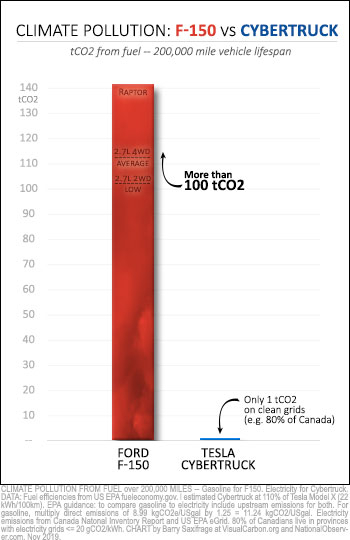
Climate pollution x100
So, we’ve done the math for you.
In this first chart, you can see how the different models of F-150 compare to the specs for Tesla’s new Cybertruck.
As you can see, the Cybertruck barely registers on the chart compared to the F-150. At the high end, the Ford F-150 Raptor will pollute more than 140 tonnes over its lifetime.
Someone buying an F-150 Raptor might as well pile up 153,000 pounds of coal and light it on fire.
In fact, if you loaded an F-150 with its own pollution, the weight would squash it flat.
Cybertruck crushes even charged on a dirty grid
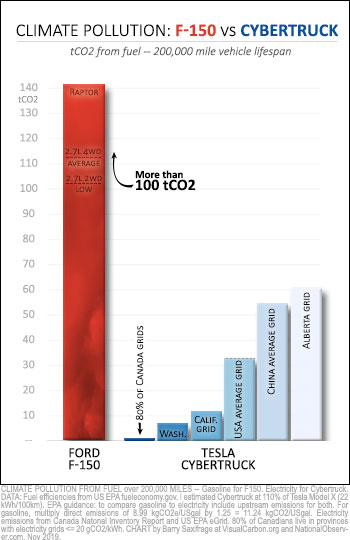
One reason the Cybertruck is so much cleaner is that electric vehicles are much more efficient.
When you run a vehicle on gasoline only about 20 per cent of energy from burning gas actually turns the wheels. Electric motors deliver 80 per cent to the wheels, so driving an EV uses just one-quarter the energy.
That means that, even if your government still has your electricity grid running on coal, the Cybertruck causes much less damage to the climate.
You can see on this second chart that a Cybertruck in China would be only half as polluting as an F-150.
And even for grids which are dirtier than China’s, like the Canadian province of Alberta or the state of Wyoming, the electric truck still has an enormous advantage.
Crushing carbon puts money in your pocket
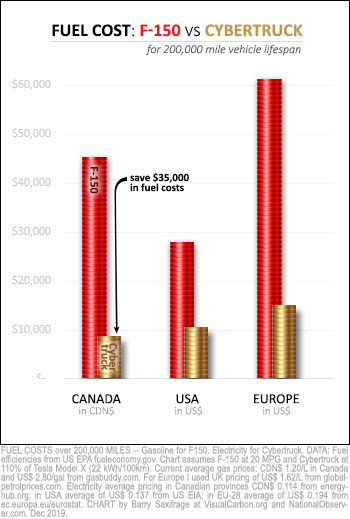
The electric truck driver is going to save a pile of money over the vehicle’s lifetime.
That’s the difference between buying gasoline for a 100 tonne CO2 truck versus charging it with electricity.
On this chart, you can see what it costs to run an F-150 versus a Cybertruck in the U.S. and Canada.
And we’ve added Europe so you can see the effect of carbon pricing. Europe prices carbon directly and member countries also have much higher road fuel taxes to disincentive gas guzzlers.
But what about the cost to buy the trucks in the first place? Surprisingly, Telsa announced a starting price for the Cybertruck of US$40,000, and $50,000 for the dual-motor all-wheel-drive version. That's right in line with the average selling price for an F-150 today at US$46,700.
F-150 more polluting than 170 countries
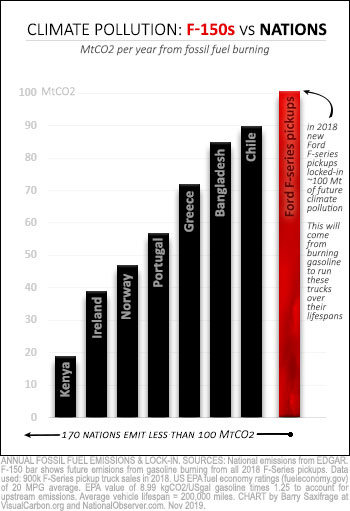
There are 193 countries in the world and each year's fleet of new F-150s locks in more climate pollution than 170 of them emit annually for everything.
Breaking climate silence
Buying a vehicle is the biggest carbon decision that most individuals will ever make. There are very few things you can buy that carry a 100 tonne weight of climate pollution. But many decisions have some level of climate impact so why don’t governments require climate pollution disclosure on products? Even in Europe, where carmakers are required to label their vehicles and include carbon statistics in any advertising, the system isn’t very user-friendly. Vehicles are labelled in terms of average grams of CO2 per kilometre.
That’s much better than the climate silence which prevails across North America. But wouldn’t it be much more effective for governments to require that product manufacturers advertise one simple number — the amount of climate pollution a product causes over the course of its lifetime? In the case of the Ford F-150, the number is a big one: over 100 tonnes.
When governments and industry begin to take climate change seriously, maybe they'll require that kind of disclosure. In the meantime, here's how it could look — all the existing information from fueleconomy.gov, but we've added a new right-hand column.
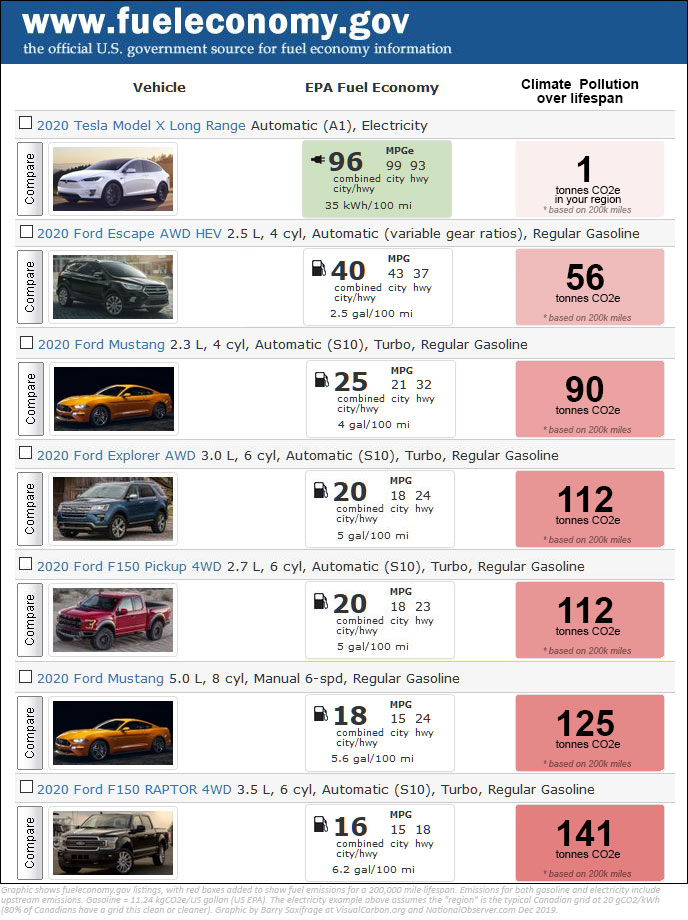




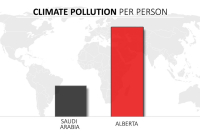

Comments
This makes incredible sense, to ask retailers to state the expected lifetime carbon emissions in the jurisdiction they're being marketed in. That would really leap out at people. A government that declares a climate emergency should leap to adopt this.
Tesla should also, in my opinion, receive a full rebate to a higher pricing level versus other EV retailers, given they are the only carmaker to have invested personally in expanding a rapid charging infrastructure network throughout North America, while other carmakers are relying on governments to fund these out of tax dollars. Nothing demonstrates more clearly that Tesla is committed to actually making, selling, and advocating for EV use, while other carmakers are still dragging their heels as much as possible. Government should calculate how much money it would cost them to put in an equivalent number of rapid chargers, at taxpayer expense, (not to mention all the chargers Tesla has just given to hotels and other destinations, to accelerate EV uptake) and extend a differential benefit in terms of cut-off level for the rebate equivalent to their savings. A move like that would appropriately reward Tesla for innovation and leadership, while incentivizing the other dud automakers to either do the same, or cut the price of their cars to compete, thus accelerating uptake.
+100!
Your point about Tesla being the only EV maker that is building a full fast charging network is excellent. All the other EV makers are dumping their cars on to the public to pay-for/install the charging infrastructure needed for them. Tesla buyers pay extra to fund a solution that doesn't burden the public.
Here in BC, nearly every non-Tesla funded DC Fast Charger was installed by BC Hydro because the govt made them. They have said they expect to lose money on all of them.
Because other EV makers aren't trying to solve the fast charging problem they are creating, they are cutting corners with cars that make the problem even harder for the public. Tesla Model 3 can charge up to 250kW. Most other EVs on the road max out at 50kW...because it is cheaper to build lower-capability cars. But the slower charging means that these EVs have to occupy each charger for many times longer. That limits the number of cars that each charger can handle.
There was an article cited in Guardian today that is worth NO featuring too, showing rapid reduction in serious health problems when air pollution is reduced. And the other day, an article published in Ontario, showing the biggest factor in terms of air pollution is the number of trucks, not the volume of traffic. All Canadian governments should consider rebating EV purchases because there's no doubt that broad uptake would lower air pollution-related health problems, like asthma and COPD flareups, heart attacks, bronchitis, and lung cancer (related to diesel exposure). Hope Tesla and others come out with their planned electric semi trucks asap, because that should make a huge difference to noise levels in cities, as well as air pollution and related health problems. There's even some data showing higher dementia rates near busy roadways. A 5K rebate to get Ford F150s and the like off the road (given most people that purchase them don't actually need a truck) would be an excellent and economical investment from every province.
+100 again. Air pollution from burning fossil fuels is now the world's leading health threat. That is reason enough to stop poisoning our air in cities with so much carbon burning on our roads.
I completely agree with your analysis..... we have a Kona electric that further confirms the advantages of EV. The initial expense is more than made up for by not having to purchase gasoline ever again......we too have heard the stats about health concerns......increased lung problems if you live close to busy roads etc., and just over a month after the vehicle finally got here, we are more than happy. EVs are clean energy, but of course not a silver bullet for climate........we have to change many aspects of our current lifestyle to reverse total emission......still getting the CO and particulate matter emissions out of our cities would go a long way to clean up urban air pollution.
The electric vehicle revolution should also help jumpstart the solar revolution........a shift in energy source that should be further along than it is....and what's perhaps best about it from our perspective, is electric vehicles tell us there are alternatives to dirty fossil fuel............and we should be getting on with the transition, not listening to old fossils who want us to believe there are no alternatives.
Thanks Chris and Barry for this very informative article.
Requiring manufacturers to post the lifetime Carbon emissions on the products is really like an extension of the Energy Guide stickers applied to new appliances so that the consumer can assess the electricity required to operate the product. Similar as well to the Fuel consumption estimate stickers on vehicles and the nutrient, calorie and fat content on food items.
I have a related question that I have not yet found an answer."What is the impact to the electrical grid as we turn over to EV's and away from gas/diesel engines"? Are we prepared to take on this new demand? Do we require some urgent planning? ??
The implications of a fast adoption of EVs vary from region to region. There isn't a single answer. From what I've read, some could handle it easily while others will need to alter current planning. Most utilities are looking at it seriously. In some cases the short-term carbon-intensity of the grid could rise for a bit to handle the extra load if the marginal supply is dirtier than the grid average. But all the grids in North America are getting cleaner so it shouldn't be a long-term issue. Many electricity suppliers have articles about their EV planning on their website.
This is one of those stories from the environmentalist wing that makes some good points but is an incomplete analysis which can lead to bad decisions. This does not take into a full life cycle of the vehicles in question. Tailpipe emissions, or lack thereof, is not the complete measure of GHG emissions. We don't need another stupid ethanol from corn decision being made when the analysis is incomplete or premature. Having said that, the approach to illustrating the differences between the two is interesting, but needs to be more complete to result in reliable long-term decisions that have less of a chance of backfiring on the environment.
I certainly agree that full-lifecycle analysis is best. However it is impossible to report on this because manufacturers don't list it, governments don't report on it and there are no uniform metrics for comparing like products. Every govt in the world that I know of that regulates vehicles does it on fuel emissions. None report on or regulate embodied emissions.
EPA/DOE (fueleconomy.gov) does report on ethanol though as it is a fuel source. Their numbers on that show how climate-dirty it is, as you allude to.
If you are interested in full-lifecycle analysis for vehicles I recommend visiting MIT's carboncounter.org. They've tried to do it for most vehicles in USA. What they show is that only cars with batteries meet even weak +2C climate target. No pure ICE does. I covered this a bit in a recent article: https://www.nationalobserver.com/2019/09/04/analysis/canadian-cars-are-…
Hi Barry,
Lifecycle data is available: there are plenty of peer-reviewed papers on the topic. For direct information, you could talk to Dr. Pete Thimmaiah, Program Lead, Zero Emission Fleets at the Fraser Basin Council. His dissertation was about this very topic and his findings were that because battery manufacturing is a very energy-intensive process, and they may have to be replaced several times during the life of the vehicle, an EV in the best possible conditions (on the BC grid for example) would emit about 30% of the GHGs emitted by a similar ICE vehicle over its lifecycle. In Alberta, you'd be emitting 60% of the lifecycle emissions of an ICE vehicle.
It sounds great - until you remember we need to reach net zero by 2030. Net zero, not net 30%. So, are EVs the right technology to be pouring public money into? Do personal vehicles belong to a sustainable future? I would love it if you and Barry explored this question. My temporary conclusion is that EVs are just another hyped-up techno-fix, which get industry and government support because it does not require us to question the role of consumerism and capitalism in creating this mess we're in.
All the best,
Julien
The carbon emissions of battery manufacture have declined significantly in the past few years. That is the reason that electric cars make sense - in the long run, they _can_ be zero emissions, while other drive trains cannot. It’s important to look at the long term for this change. A new technology will always start out with significant inefficiencies, but then rapidly improve.
Absolutely.
As recently reported:
https://www.teslarati.com/tesla-model-3-batteries-less-polluting-than-3…
It is also worth noting that Lithium is almost entirely reusable when a large battery is recycled, but first, car batteries can provide years of service after they are no longer suitable for use in cars. (Tesla also successfully manufactures and sells globally the kinds of large energy storage solutions referred to in this piece.)
https://www.bloomberg.com/news/features/2018-06-27/where-3-million-elec…
See also:
https://www.tesla.com/utilities
This is a mix of corporate propaganda and techno-fantasy. Lithium cannot yet be recycled economically, just like CO2 cannot be scrubbed from power plants. There is no technology on the horizon that will allow mining using electricity (of lithium and other metals required to manufacture passenger vehicles), and there is no obvious way of greening up the electricity supply. There also is no technology that can replace plastics (not in the amounts we need, anyway).
So how exactly do we consider EVs to be a good solution? Emissions need to hit net zero in the next 10-20 years - there is no "long-term" and waiting for elusive and unlikely efficiency improvements is not an option.
Note that the Ford T used the same technology as today's vehicles. Similarly, most cars from the 60's had a better fuel efficiency that today's (less efficient engines but way less energy-sucking gadgets inside).
Buying a new car may help your conscience, but it won't help the Earth.
Yes. We have a denialist tendency to assume that new technologies have already reached their peak...imagine if we'd assumed that of the first model T or the Wright Brothers quaint little almost flying machine?
We now have carbon-neutral synthetic fuel becoming available, and I think the author is also rather optimistic about the efficiency of the grid. However, the BIG issue is that this is just another bloated identity signal. A truck is supposed to be a practical tool, not a trendy sculpture. There is no excuse for a land vehicle to weigh more than its average payload, or ignore streamlining. We got used to adding weight with cheap energy, and the marketing people have been taking advantage of that ever since, so now this madness looks normal. An electrified velomobile is all a commuter needs for all weather use, and it has many secondary benefits.
I personally agree that pickups are overkill for most uses. Unfortunately the 100tCO2 F-150 has been the most-sold passenger vehicle in North America for decades. Americans and Canadians are buying crazy big numbers of pickups.
Europeans not so much. Because they charge themselves more in gas taxes. We could raise our gas taxes by 10c/L per year for a decade like the Conservative govt did in the UK in the 1990s. I'd vote for that! Then pickups would disappear here too. But until we change the rules on climate pollution, fossil-burning SUVs and pickups are a major climate threat.
As far as "sculpture" and "streamlining", from what I've read the Cybertruck has a much better streamlining than existing pickups. Musk was saying they might get to 0.3 Cd which would be far above any pickup truck on the market. And the angular shape is because it isn't possible to bend the kind of steel they want to use to allow them to produce a million-mile-lifespan truck that requires almost no maintenance. So it is a bit of form following function. Creating a long-lasting, long-range EV truck requires doing things differently to get better aerodynamics and longer life than existing pickups. At least that is what they say their goals and reasons are. We will see when it actually comes out...
Makes sense to me that form should follow function.........I've never cared for big trucks........but I find myself almost lusting for this Tesla machine..........so almost Wonder Woman....wonder if we can ask for a custom paint job?
Kudos to these reporters and the National Observer for providing information that industry and governments are concealing.
While interesting to see a comparison between an existing IC truck, the Ford F-150, and a hypothetical electric vehicle, it would be much more relevant to learn about real options that exist today. The F-150 performance is awful and there must be far better available choices. What are they?
Are comments closed? I made the point earlier today that comparisons between an available vehicle, the F-150, and a possible future alternative are, at best, interesting, but not helpful if one is considering buying a vehicle now.
What would be useful is a comparison of lifecycle carbon contribution of currently available vehicles.
A job for NO?
This is absolutely good news and we hope Tesla can follow through....we've just purchased an electric vehicle and are amazed by how good it is, and how seldom we have to charge it..........just approx 3- 3 1/2 times a month....and when you have a solar array, driving suddenly costs you nothing.......
If we can replace those gas guzzling trucks in the next decade, there might be hope for us.........We're all in for electric. Trudeau should consider buying an automobile factory, instead of a pipeline.....its the future.
Agreed! All those Oshawa plant workers could be retrained... we have never had an All-Canadian vehicle company. Maybe now is the time... and let’s make it EV.
But what's the carbon footprint of the vehicle manufacture and delivery? The difference in fuel is pretty obvious, hardly required a story.
But, you know, when nuclear is discussed, anti-nuclear people (it's an "identity", not a position, as David Roberts at Vox observed) immediately jump to exaggerated calculations of the carbon footprint of the nuclear plant construction. (Helen Caldicott used a particularly indefensible calculation.) A widely-accepted number is 6% of the carbon emissions that are being averted with the carbon-free fuel.
The equivalent for e-cars should be a well-known and well-discussed point, so that people don't come to believe they can still have a car over public transit, because there are zero consequences to the purchase decision. There will be significant consequences until we have green steel, green aluminum, green plastic, green lithium, and green auto factories.
We don't. So you need that number, Barry, and Tesla needs to start publishing it instead of forcing you to estimate.
The cost of nuclear is prohibitive.......the time line to completion of any plant too long, the radioactive half life of plutonium humanly unimaginable, and finally...I don't think there's enough uranium globally to gear up to half of what we'd need........if we chose the nuclear solution.
But some men like BIG....and CENTRAL...solutions. It's the current hierarchical model that we have working (sort of ) for us now. Equating electric vehicles, and renewable wind and solar with nuclear......arguing that our preferences spring from our 'identity'......and overlooking the differences inn time line, scale and cost.....seems like pursuing a false analogy to this old language teacher.
Yes, we'll have to scale back our consumerism, drive less, live more locally. Yes, electric vehicles are only one part of the transition we need to embark upon. But we should all be fed up with know it alls who poo poo new technologies and come to the defence of old business models like nuclear....can tar and fraced gas be far behind in this line of reasoning?
Whether electric transportation and renewable energy can sustain us..........for certain sure it won't blow up in our faces like Chernobyl, or succumb to extreme climate change weather events like Fukushima . We need to learn to think small, resilient, and local again....go back in time for winter........and summer, in place. And renewables make that shift more possible every year.
Nuclear power comes in several forms. All are very expensive, so you are correct on that point. It is, after all, a rather complex way to boil water.
Safety is always cited when someone tries to knock nuclear off the list of energy alternatives to fossil fuels. This is also valid as applied to the accidents knowingly caused by human error or design flaws.
Chernobyl was both a faulty design using graphite in its control rods and in its reactor design that eliminated containment buildings due to cost. The explosion was also attributed to the gross incompetence of some bosses and the bureaucratic inertia of the Soviet nuclear power administration. HBO and the UK’s Sky network recently released a five-part series on Chernobyl that is exemplary. It’s based on the tapes made by the chief scientist sent to deal with the Chernobyl disaster before he committed suicide. Then tapes were eventually smuggled out.
The Fukushima disaster was not caused by a “climate change weather event.” It was caused by a 9+ subduction earthquake and the resulting one metre drop in elevation of the land. It was also caused by the stupidity of locating a nuclear power plant right on the seashore in a highly active seismic zone subject to massive tsunamis with an inadequate wall to prevent the emergency diesel generators driving the backup reactor cooling system from being flooded. In other words, a design flaw. If the backup generators were located on a hill near the plant, then they would have worked and prevented the explosions that disabled the reactor and caused the leakage of radioactivity, and Fukushima would never have been synonymous with Chernobyl.
The coal industry has killed hundreds of millions worldwide over its history. Added to that is the millions killed and debilitated by burning refined petroleum in our cities. Nuclear power has not resulted in anywhere near this level of death and disease, though Chernobyl, through the most recent science-based evidence and estimations, is or will be responsible for about 94,000 deaths in Ukraine, Belarus and western Russia. Fukushima will be in the thousands. Most certainly all are unacceptable deaths, but not in any legitimate way comparable to the numbers caused by burning fossil fuels.
The elephant in the room is the spent uranium waste from last generation reactors. It will never be dealt with adequately if nuclear is eliminated from consideration in favour of renewables only or, god forbid, going back to coal. The spent rods are currently immersed in pools of water on Canada’s reactor sites. Deep repositories in geologically stable rock formations are a ludicrous solution when you consider the half-life of spent uranium fuel is in the hundreds of thousands of years. Giving up on nuclear will not resolve this problem.
This is where next generation small modular reactors (SMR) can play a role, not primarily as a tool in a climate-fighting policy toolkit, though that is surely valid, but as a way to render down the existing waste uranium over and over for years until it becomes a much weaker glass-like material with a very small fraction of the half-life, allowing it to be safely sealed in canisters in specialized repositories. SMR could generate electricity for decades on the existing sites using the spent waste, a net benefit that does not require additional mining or transport.
If it weren’t for the problem of dangerous waste products that came out of older reactors, then renewables are certainly in the position to overtake nuclear, especially on cost and distribution on a more decentralized domestic front. That will still be a challenge when you consider that nuclear comprises ~80% of all electricity in countries like France with a vast devoted transmission network, and where some industries need huge, concentrated power inputs. However, that is not an insurmountable challenge in countries like Canada where geothermal in BC, Yukon and Alberta can help supplement hydro in a very big way on the centralized grid, all perfectly exported across the continent with a smart low impedance transmission grid, while solar and wind with stable power storage continually pepper the remaining grid.
Advances in large-scale power storage seem to be gearing up to be introduced just as electricity demand will increase with electric vehicles.
The liquid metal battery shows tremendous promise as a superior performer, a cheaper to make product using common materials, and longer-lasting technology. MIT will be releasing theirs in the early 2020s (developed by a Canadian engineer). It uses magnesium, antimony or aluminum with a salt electrolyte and is contained in a ceramic enclosure. It can be put through multiple 100% charge-discharge, hot liquid-cold solid cycles and retain performance over years in the high 90% range.
It may be possible to devote liquid metal batteries to large industrial or city-scale storage of power from renewables, offering stable base load power 24/7/365 from intermittent sources, thus displacing large-scale storage with the far more expensive lithium ion battery. In turn, this will allow more lithium ion (or possibly zinc ion) batteries to be used primarily in smaller applications, such as cars and trucks. More available lithium will likely foster a revolution electric battery-driven buses and trucks. Moreover, charging stations could be placed in remote locations powered by wind and solar with LM storage linked by satellite and digital controllers. LM batteries with renewables can also foster more sustainable urbanism with district power grids, and take the pressure off the provincial grids to a degree.
All this talk about EVs and renewables will not negate the fact that our cities need to be redesigned. The single-family detached house is obsolete in sustainable cities. The most efficient and healthy form of transport ever invented remains the walking human. It’s not hard to envision walkable neighbourhoods with high streets containing all the work and living necessities, including grocery stores supplied by local farms (e.g. Metro Vancouver and the local Agricultural Land Reserve) growing year round produce with small market farms and gardens and greenhouses with a fleet of small electric delivery trucks. Electric transit in its myriad of modes should be expanded to meet both local and long-distant commuting demands. Electric intercity high-speed rail can and does displace short and medium-haul flights where both are available (e.g. Most of the the EU).
These are some of the elements that could make up the painfully overdue Transition Plan so long ignored by our senior governments.